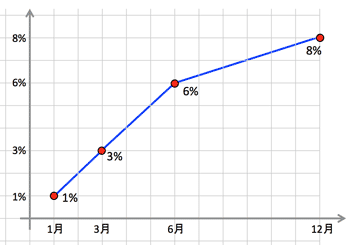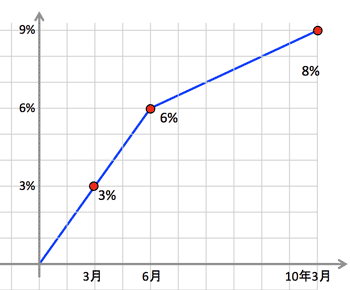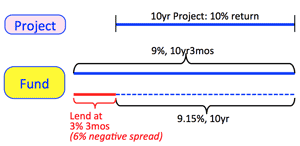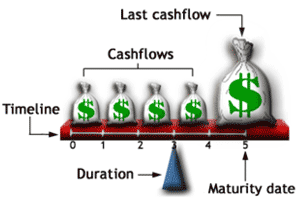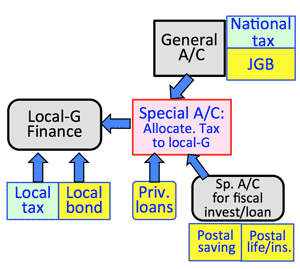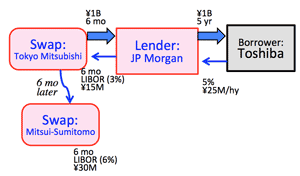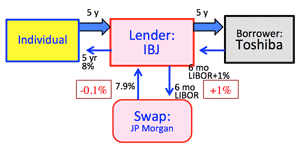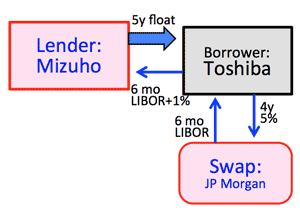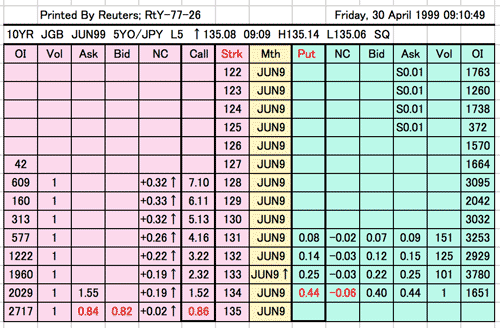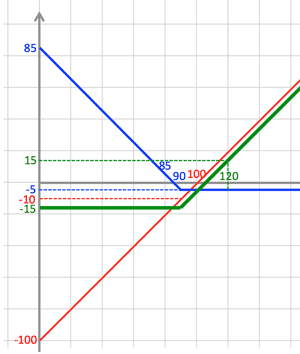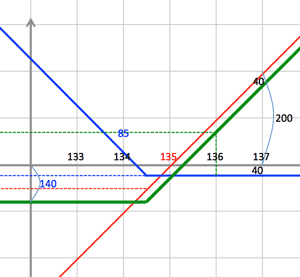>Top 1. Exchange market:
- Bid rate and Offered rate:
- 121.25-35 ¥/$: means the highest bid rate of a buyer is 121.25; the lowest TTS (Telegraphic Transfer Selling rate), Middle rate, TTB (Telegraphic Transfer Buying rate:
- Considering:
- Mine; Yours (121.35 yours); Done (=agreed the transaction)
- EBS (Electronic Brokering Service): a wholesale electronic trading platform to trade FX (Foreign eXchange)
- ICAP; <Intercapital listed in London Stock Exchange
- FRB of US is a member of the ICAP, but BOJ is not.
- How to earn a trader of FX?
- A: Buy FX cheap, and sell it high.
- C: There will be no low-risk & high-return product.
- C: The business is ± interest and exchange rate.
- Order of the transaction:
- around 500M at the difference of ¥0.3/
- The breakeven will be the sum of 500M×0.3 ¥/=¥150M
- >Top Futures contract (or futures), or forward contract:
- The parties agree to buy and sell an asset for a price agreed upon today with delivery and payment occurring at a future point. (derivative product)
- Currency futures, interest rate futures and stock market index futures.
- Forward exchange rate is not an estimate after 1 year; which is automatically calculated by interest difference of the spot.
- Spot contract:
- A: Actual delivery is 2 days later.
- Why exchange rate fluctuate?
- A: fundamentals (or national power)
- A: Keynesian beauty contest
- A: Difference of interest rate
- A: Balance of payments; trade surplus increase, $ selling pressure increases.
- C: 1) Goods & services balance+2) Income balance+3) Current capital transfer balance+4) Foreign exchange reserve+5) Errors & omissions
(Current A/C=1+2, and Capital A/C=3)
- Japan tends to emphasize the sizezof goods balance, underestimating the impact of services balance; recent Japanese are mostly pensioners, whose life is depending on income by the interest and dividend.
- Structure of balance of payments of Japan has changed:
- In 1985:big surplus of goods balance (trading nation)
- In 2001: mostly depend of income balance
- B: there will be no $ selling pressure.
- Q: Do the foreign investors sell Japanese stock when ¥ becomes weaker?
- B: Investment profit and risk hedge of exchange are different.
- Repatriation problem:
- B: Japanese banks mostly procure and operate in $ in transaction in US. They rarely reflux their profit to HQ in Japan changing into ¥.
- US banks evaluate the transaction by the market value, not by the book value, so they have no incentive to sell assets as of end of the accounting period.
- $ buying in emergency:
- Maxima about the market: buying in the distant war, selling in the near war.
- Internal exchange rate:
- if the internal rate was determined at ¥130/$, Japanese companies tend to sell at the rate slightly higher than the internal rate, considering discount rate of the forward. (say, ¥131 or ¥132)
- >Top Foreign exchange intervention:
- B: J-Government or BOJ are one of participant, who could move the market trend.
- C: but, they could be an adjuster of the ¥ level and its real economy.
- Their ¥ fund will be procured by issue of FB (Financial Bill);
- Balance of FB: ¥57T (2003)
- Sterilized intervention (>)
- C: FX intervention is a powerful carry trade.
- Super-preferential rate?:
- Seller's rate (6mos future) is not preferable.
- Credit risk:
- Spot exchange inter banks: there is 2 days risk.
- Future exchange with individual: there is a risk.
- Economic measures (FFE):
- 1) Fiscal policy, 2) Financial policy, 3) Exchange policy.
- Plaza accord (1985): to make weaker $.
- Lourvre accord (1987): to adjust too weaker $.
- RMB: 1.5 RMB/ (c1980), now 8.3 RMB/ (1995-)
- Weaker exchange rate means; stronger competitiveness (more jobs) and weaker ppp
- Weaker ¥ is better than dismissal of labor (=hollowing out of industry)
- Debt in foreign currency denominated: cannot make weaker of the local currency.
- Asian currency crisis in 1997:
- Most of Asian countries adopted fix rate or being pegged to $.
- Fix rate or $ peg is indispensable to induce foreign investment.
- Capitalism=Market mechanism=Speculators are indispensable.
- Market is not sustainable only by actual demand.
- Market system which is attacked by speculators; the system is worse than the speculators.
- "Speculators are haunting in the market."
|
1.
為替マーケット:
- Question?:
- Answer:
- A: .... Affirmative 肯定的コメント
- B: .... But then 否定的コメント
- C: .... Considering 別要素コメント
- Simulation:
| Fund |
¥1200K,. |
=$10K |
| Spot rate |
¥120/$ |
|
| ¥ deposit |
+1.0% pa |
¥1212K |
| $ deposit |
+5.0% pa |
$10.5K |
| $ futures 1y |
@120 |
¥1260K |
| |
@119 |
¥1250K |
| |
@118 |
¥1239K |
| |
@117 |
¥1229K |
| |
@116 |
¥1218K |
| |
@115 |
¥1208K |
| |
@114 |
¥1197K |
- 国際収支=経常収支+資本収支
- 経常収支:
- モノサービス収支: 給与ボーナス
- 所得収支: 利息配当
- 資本収支: 元本
| 貿易統計 (B¥) |
1985 |
2001/8 |
| 経常収支 |
12,573 |
725 |
| |
貿易サービス収支 |
11,254 |
-40 |
| |
|
貿易収支 |
13,447 |
491 |
| |
|
サービス収支 |
-2,193 |
-531 |
| 資本収支 |
-13,338 |
726 |
| |
投資収支 |
-13,243 |
737 |
| |
|
直接投資 |
-1,507 |
-292 |
| |
|
証券投資 |
0 |
-1,401 |
| |
|
その他投資 |
0 |
2,369 |
| 外貨準備高 |
$28B |
$37,222 |
- FB: Financial Bill, 政府短期証券
- 外為特別会計 (FX special account)
- MOF:
-
- BOJ:
-
- BS of Monetary Authority
-
| D-credit |
Currency issue balance ↗ |
| F-reserve ↗ |
- 不胎化介入1 (Sterilized intervention):
為替介入による通貨供給量の相殺
- 急な円高→円売介入→円の下落
- 通貨供給量増加→金融緩和効果(金利低下)
- 売りオペ→市場余剰資金吸収→金利下がらず→為替介入効果薄れる
- 不胎化介入2
- 急な円安→円買介入→円の上昇
- 通貨供給量減少→金融引締効果(金利上昇)
- 買いオペ→市場に資金供給→金利上がらず→為替介入効果薄れる
- FX Rate:
| Spot exchange |
6 mos future |
| TTS |
121 |
Seller rate |
120.00 |
| Middle |
120 |
Middle (int-bk) |
118.70 |
| TTB |
119 |
Buyer rate |
117.40 |
|
